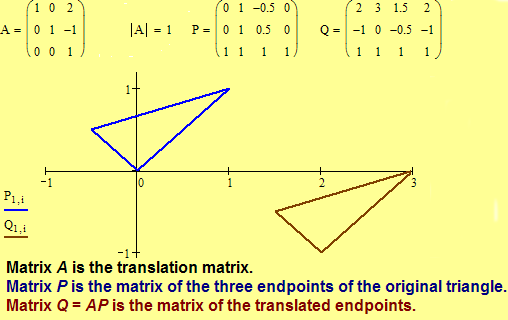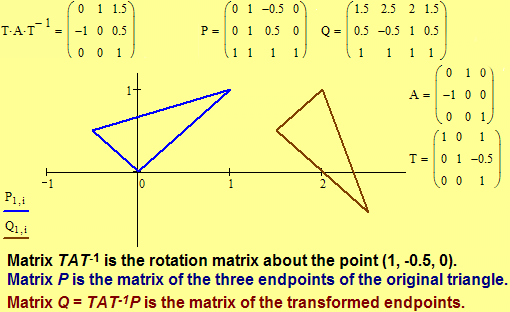3.4.2 Translations and Rotations for the
Analytic Euclidean Plane Model
![]() Printout
Printout
In a few minutes,
a computer can make a mistake so great that it would take many men many months
to equal it.
—Merle L. Meacham
The
investigations from the last section indicate that a
translation or a
rotation
of the Euclidean plane is a direct isometry.
![]() What form does the matrix of an
affine translation of the Euclidean plane have? Let's investigate that
question. Let TPQ be an affine translation of the Euclidean plane
with vector PQ = (a, b, 0) and
let A be the translation matrix. Let
X(x1, x2, 1) be an arbitrary
point in the Euclidean plane with image X'
under the translation TPQ.
What form does the matrix of an
affine translation of the Euclidean plane have? Let's investigate that
question. Let TPQ be an affine translation of the Euclidean plane
with vector PQ = (a, b, 0) and
let A be the translation matrix. Let
X(x1, x2, 1) be an arbitrary
point in the Euclidean plane with image X'
under the translation TPQ.
Since XX' = PQ, for every X
in the plane. Hence,
and
for every X
in the plane. Since the two expressions are true for all points X, we substitute with particular values
for the point X. Let X = (0, 0, 1), then a13
= a and a23 = b. Let X = (1, 0, 1), then a11
– 1 + a = a
and a21 + b = b.
Hence, a11 = 1 and
a21 = 0. Finally, let X = (0, 1, 1), then a12 + a = a and a22
– 1 + b = b.
Hence, a12 = 0 and
a22 = 1. Hence,
Since the det(A) = 1, a translation is a direct isometry. We summarize our results above and from the previous section with the following proposition. (Part (b) is left for you to verify in Exercise 3.65.)
Proposition 3.13. (a) An affine translation of the Euclidean plane is a direct isometry. (b) Any affine direct isometry of the Euclidean plane with no invariant points is a translation. (c) The matrix representation of an affine translation of the Euclidean plane TPQ, defined by vector PQ = (a, b, 0), is
Click here to view an animation of the following example.
Next, we
investigate the form of the matrix of an affine rotation of the Euclidean
plane.
![]() To simplify the problem, we first consider the problem with the center
of
rotation
at the origin. Let
To simplify the problem, we first consider the problem with the center
of
rotation
at the origin. Let be an affine rotation of the Euclidean plane
with center O(0, 0, 1) and let A be the translation matrix. We proceed in a similar manner as with
the derivation for the translation matrix.
Let X(x1, x2,
1) be an arbitrary point in the Euclidean plane with image X' under the rotation
.
Since the center of a rotation is invariant, O(0, 0, 1) maps to itself; therefore, the matrix must be of the form
By trigonometric definitions of the circular functions, maps the point (1, 0, 1) to
and the point (0, 1, 1) to
.
Hence,
and
Hence, A
has the form
Note that the det(A)
= 1, hence, A is the matrix of a
direct isometry. We must show that A
is the matrix of the rotation. Since A
is the matrix of an isometry, XO = X'O for any point X distinct from the center O. Once we show that for any point X
distinct from O, ,
by definition matrix A would be the
matrix of the rotation
.
Since X' = AX, we have
The sides of
are contained in the lines
and
Substitute into the formula for the angle
between two lines,
If the center of
rotation, C, is at a point other than the origin O,
we translate the center C to the origin, rotate
about the origin, and translate back to C,
i.e. We summarize our results above and from the
previous section with the following proposition. (Part (b) and (d) are left
for you to verify in Exercise 3.65.)
Proposition 3.14. (a) An affine rotation of the Euclidean plane is a direct isometry. (b) Any affine direct isometry of the Euclidean plane with one invariant point is a rotation. (c) The matrix representation of an affine rotation of the Euclidean plane with center O(0, 0, 1) is
(d) The matrix representation of an affine rotation of the Euclidean
plane with center C not at O is
Click here to view an animation of the following example.
Exercise 3.57. Find a matrix of the translation that maps the point X(3, 8, 1) to Y(5, 1, 1) and find the image of Z(12, 7, 1). Is the matrix unique?
Exercise
3.58. Find a matrix of the translation that maps the line l[2, 3, –1] to m[2, 3, 5]. Is the matrix unique?
Exercise 3.59. Find a matrix of the rotation where C(2,
1, 1) and find the image of X(3, 6,
1).
Exercise
3.60. Find a direct isometry that maps X(1, 1, 1) to X'(–1, 1, 1)
and Y(3, 0, 1) to Y'(0, 3, 1). Is it a translation or a
rotation?
Exercise 3.61. Let the point of intersection of the lines l[1, –1, 0] and m[1, 1, –2] be the center of a rotation that maps l to m. Find the matrix of a rotation that maps l to m.
Exercise
3.62. Let the point of intersection of the lines l[–1, 5, 1] and m[3,
–2, 4]
be the center of a rotation that maps l
to m. Find the matrix of a rotation
that maps l to m.
Exercise 3.63. What is the form of the inverse of an affine translation
of the Euclidean plane? Affine rotation?
Exercise
3.64. Prove the set of affine translations of the Euclidean plane is a
group under matrix multiplication.
Exercise 3.65. (a) Verify part (b) of Proposition 3.13. (b) Verify part (b) of Proposition 3.14. (c) Verify
part (d) of Proposition 3.14.
Exercise
3.66. Prove the set of affine rotations of the Euclidean plane with
center C is a group under matrix
multiplication.
|
3.4.1 Translation and Rotation |
|
© Copyright 2005, 2006 - Timothy Peil |

